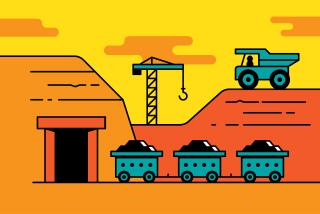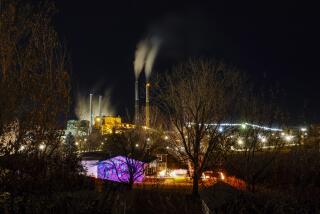Lodes of Work : Tungsten Mine in Mt. Baldy Canyon Is Unique; So Are Obstacles Owners Face
To get there, Ronald Curtis heads out of Mt. Baldy Village along the Glendora Ridge Road until he reaches a metal gate riddled with bullet holes. He opens the gate and aims his dusty Jeep Cherokee down a dirt road, winding along a rocky flank of Mt. Baldy.
After a lurching eight-mile ride, he pulls into the bottom of Cattle Canyon, where a herd of Nelson bighorn sheep forage along the stream bed, scampering nervously up the sheer sides of the canyon as the Jeep approaches.
Here at last is the Curtis Tungsten Mine, a ravel of tin sheds and earth-moving equipment sitting incongruously in the middle of a wilderness 5,000 feet up the side of the mountain. The only operating commercial tungsten mine in North America, according to the U.S. Bureau of Mines, the Curtis mine is poised to chisel and blast an estimated $250 million worth of the heavy metal out of those canyon walls.
“We don’t break any records going to the bank, but we do all right,” said Curtis, 43, a cantankerous Vietnam veteran who has tangled with federal bureaucrats, lawyers and conservationists in keeping his mine open for 17 years.
By next month, Curtis expects his the mine to be turning out 88,000 pounds of the stuff a month. That will bring in a cool $300,000 at current prices, said Curtis. And he’s expecting prices to go up.
For the first time since Curtis took over the operation in 1973, the mine will be running round-the-clock, with eight miners and laborers drilling into rock, trucking ore down a precipice and feeding the material into a milling plant, which crushes rock and winnows out the final product that’s used to make light-bulb filaments, radiation screens, computer chips and drilling equipment.
Tungsten is at the rough-edged, unglamorous end of mining. “You’re not going to find a 400-pound nugget of gold today and be a millionaire tomorrow,” said Curtis, a trim, wiry man who is blind in one eye and partially deaf from a blasting accident 14 years ago.
As vital as the element is, there has been an abundance of it on the world market in recent years. Most of it comes from China. “Back in 1985, the Chinese dumped 20,000 metric tons on the market,” Curtis said. “That killed it for us.”
But the price has been edging up recently, from less than $40 for the standard unit of 20 pounds in the mid-1980s, to $72 now. With European countries imposing a new duty on Chinese tungsten, Curtis said, the price may soon get up to $100.
So it’s full speed ahead for the Curtis mine. Curtis and his wife, Claire, have taken the company public, raising more than $800,000 through a stock offering a year and a half ago.
This is wild country up here, with towering big-cone firs high up on sheer granite walls and a boulder-choked stream bed that, in a rainstorm, can turn into a raging torrent. Designated by Congress as the Sheep Mountain Wilderness in 1984, the canyon is off-limits to any motorized vehicle, or even dirt bikes, except those belonging to the mine.
Curtis’ father, Andrew Curtis, an amateur prospector, stumbled into the canyon in 1951 and discovered a substantial tungsten lode, claiming 1,500 acres of it in 1952.
The claim just sat there for more than 20 years, a family treasure waiting to be exploited, said the younger Curtis, whose father was killed in an automobile accident in 1969.
Curtis graduated from high school in Ontario, went to Vietnam, then to the Colorado School of Mines. A month after he graduated in 1973, he set up operations in the canyon.
It has been a struggle ever since. “Mining and milling are easy,” Curtis said. “It’s the politics that’s hard.”
Conservationists, seeking to protect the bighorn sheep, have sought to close him down. “It’s the lambing area, right there where the road goes,” explained Loren Lutz, head of the Society for the Conservation of Bighorn Sheep.
In fact, the U.S. Forest Service did close the road to the mine for several months, as federal administrators prepared an environmental impact study. “We were hiking in several times a week--190 miles a month,” Curtis recalled bitterly. He responded with a $1.25-billion suit in 1984, claiming that the federal government was cheating him out of his claim.
Things have settled down since then. Although a federal judge threw out the suit, Curtis has been allowed to continue mining under a “grandfather” provision in the bill that declared the area a wilderness. There are, however, some restrictions on the number of round trips miners can make along the road to the mine. That means just four trips a day during lambing season--April, May and June--and 24 a day for the rest of the year.
That’s plenty to get his supplies in and his product out, Curtis conceded.
On most conservation issues, Curtis remains a hard-liner. Asked to identify some trees near his milling plant, Curtis shrugged and said, “When I look at a tree, I see firewood.”
But he and conservationist Lutz have reached an understanding. “We agree on most things,” Lutz said. “The one thing we disagree on is vehicular traffic on that road during lambing season.”
Curtis, grudgingly abiding by the restrictions, has even developed an affection for the bighorns, which meander through his camp, snitching pieces of nylon rope and chewing up the miners’ work gloves. The other day, Curtis marveled openly at a rare glimpse of some lambs, for whom he must endure a three-month slowdown.
In a wilderness operation, with no access to a paved road, mining has to be efficient. Curtis has kept the Cattle Canyon mine lean and efficient.
“There’s no big company mentality here,” he said. “When you’re mining here, you won’t be sitting in no office. Everybody works.”
Russell Raney, a Bureau of Mines physical scientist in the western field operations office in Spokane, Wash., said Curtis has developed a reputation as an innovator. “He makes a lot of his own machinery,” Raney said. “That milling plant just takes one guy to run. Milling can be very labor-intensive.”
Curtis also has been blessed with especially high-grade tungsten, Raney added. “Other folks grunt to get their tungsten,” he said. “This just seems to fall from the sky.”
The modern way to find tungsten is with an ultraviolet “black light.” The miner, carrying a portable lamp, goes deep into a mine shaft that has been drilled out of the solid rock, about 1,000 feet above the canyon floor. He shines the light on the shaft’s ceiling, and the tungsten shows up as a streak of glowing blue in the granite.
“There’s a 4-foot vein of it, going right up to the top of the mountain,” Curtis said.
Mining at the Curtis mine means blasting the ore out with dynamite and hauling it down a treacherous mountain road (which Curtis carved out himself) to the milling plant, which looks like a huge, rattling Rube Goldberg machine.
The ore works its way through a series of screens, from which larger rocks are fed into a pair of crushers. At the bottom of the plant, two large concentrating tables jiggle a mucky mixture of sand and tungsten, separating out the metal. The final product, scooped and dried, looks like gray beach sand. The miners transport it out of the canyon in metal barrels.
Ultimately, Curtis may have become an environmentalist in spite of himself. He and his men religiously carry trash out of the canyon. They help police the area against illegal hunters or dirt bikers. Curtis, the good citizen, figures it this way: “There’s no need to rape and pillage in order to get the tungsten out.”
More to Read
Sign up for The Wild
We’ll help you find the best places to hike, bike and run, as well as the perfect silent spots for meditation and yoga.
You may occasionally receive promotional content from the Los Angeles Times.






